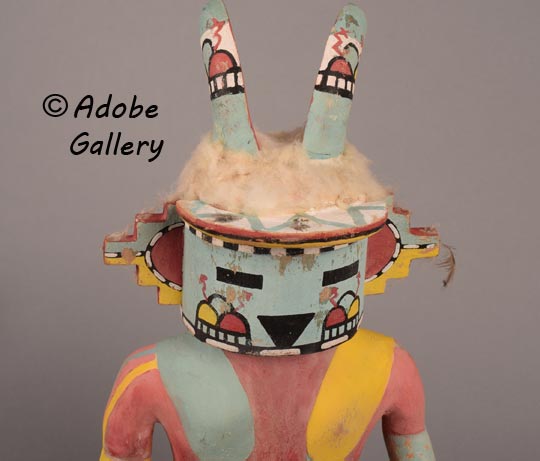Hopi Pueblo Large Muy-ingwa Katsina, Germination God Kachina Doll Carving
+ Add to my watchlist Forward to Friend
Forward to Friend
- Category: Traditional
- Origin: Hopi Pueblo, Hopituh Shi-nu-mu
- Medium: wood, paint, cotton, feathers
- Size: 17-¾” tall
- Item # 26312
- Price: $1950
Muy-ingwa: The Majestic Cottonwood Carving of the Two-Horn Germination God
Standing at an impressive height of nearly 18 inches, this carving, crafted from cottonwood root, represents Muy-ingwa—the Two-Horn Germination God. With a width of 7-½ inches from hand to hand, this broad-shouldered figure exudes a commanding presence.
Muy-ingwa is adorned in traditional attire, including a kilt, an intricately embroidered sash, and a woven belt. His mask, a remarkable feature, showcases two elongated horns that emerge from a head enveloped in cotton. His face, painted in a striking shade of blue, is adorned with rain clouds on each cheek, and an extended sun shield protrudes from the top of the mask. His ears, shaped like clouds, along with additional clouds on his cheeks and the pair of horns, further enhance celestial symbolism. The cotton, naturally, represents clouds.
Muy-ingwa holds a significant place in Hopi mythology as the deity of reproduction, governing the life cycles of humans, animals, and plants. Residing in the underworld, Muy-ingwa responds to the desires of farmers by sending up plants from the underworld, guided by the types of seeds they plant.
During the Wuwuchim ceremony in November, Muy-ingwa is impersonated. The impersonator's headdress, carrying two backward-curving horns, is a key feature of this ritual. This cottonwood carving of Muy-ingwa serves as a tangible representation of these rich cultural traditions and beliefs.
"The religion of the Hopi Indians in certain ways resembles that of the ancient Greeks. It is polytheistic, because there are many gods, and animistic because of the belief that all animate objects, plant and animal as well as some inanimate things, have spirits that the Hopi visualize in human form. When a Hopi goes out to gather yucca roots to use as a shampoo, the first plant he finds, he prays to and passes by, gathering the second one. When he goes hunting he prays to the spirit of the game and apologizes for having to take their lives.
"In the mind of the Hopi there is a distinction not very sharp between the deities and the spirits of objects. The spirits of men, animals, and plants are the kachinas which are often impersonated. The spirits of some of the deities appear as kachinas and are impersonated, but most of the deities are never impersonated or even represented by images." [Colton, 1959:77]
Condition: good condition with minor paint abrasions
Provenance: this Hopi Pueblo Large Muy-ingwa Katsina, Germination God Kachina Doll Carving is from the collection of a gentleman from California
Reference: Colton, Harold S. Hopi Kachina Dolls with a Key to their Identification, University of New Mexico Press, Albuquerque
TAGS: Hopi Pueblo, Katsina Dolls, Apache Indians

- Category: Traditional
- Origin: Hopi Pueblo, Hopituh Shi-nu-mu
- Medium: wood, paint, cotton, feathers
- Size: 17-¾” tall
- Item # 26312
- Price: $1950
Adobe Gallery Recommended Reading
Adobe Gallery Recommended Items
If you are interested in this item, we would also like to recommend these other related items:



